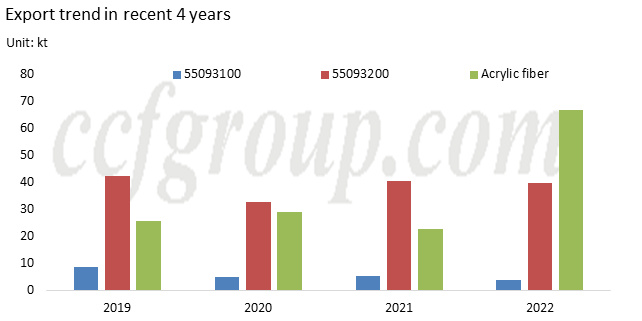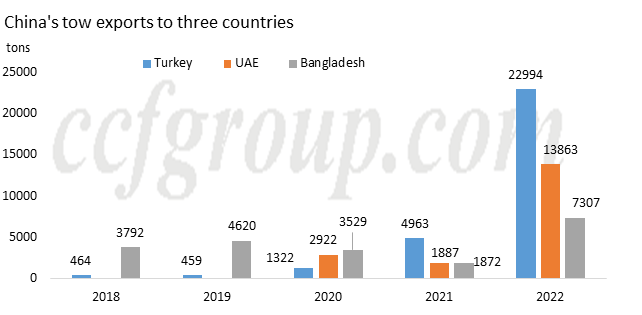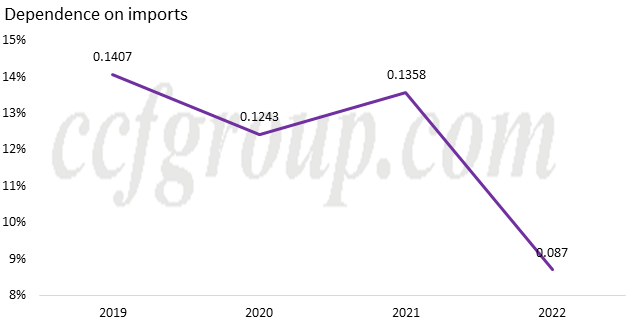Precautionary thinking under acrylic fiber trade surplus
Investors often have a saying, "Don't put all your eggs in one basket." Let's look at a set of data.

As shown in the figure, while the export of main acrylic yarns has not increased significantly and even decreased slightly in recent years, the export volume of acrylic fiber has witnessed significant rise, mainly embodied by the doubling in 2022. According to the data, the total export volume of acrylic fiber in 2022 was about 67kt, rising sharply by 195% compared with 22.7kt in 2021. The export of acrylic yarn was in a relatively stable state, and that of 55093100 even showed a gradual decline.

In terms of the top three export destinations, exports to these regions showed a meaningful increase in 2022, with increments ranging from 3 to 7 times. Compared with the increase of only a few hundred tons for short fibers, the rapid growth of acrylic tow exports has, to some extent enabled the domestic acrylic fiber unit to maintain a high operating rate for a long time, reducing the cost increase caused by production reduction. Although export volume in the first quarter of 2023 decreased by about 2,500 tons compared to the same period in 2022, it still remained at a historically high level.
![HOEI9BURW4_AFB{SMA1]6DW.png HOEI9BURW4_AFB{SMA1]6DW.png](https://pic.ccf.com.cn/2023/05/20230518092233487.png)
With regard to the operating rate, it is obvious that since 2022, except for the "cliff" during the large-scale unit maintenance, O/R of AF plants have stayed at a high level over the years. The average operating rate in 2022 is about 75%, which is significantly improved from less than 60% in the previous two years.
The increase of exports also indirectly reflects the decreased dependence on imports. In 2022, the acrylic fiber imports were about 46kt, down by 39% compared with 75kt in the previous year.

However, stable production capacity and increasing exports also reflect the weakening of linkage between China's domestic acrylic fiber production capacity and its internal demand, and the increasing dependence on foreign buying. As for the specific situation of the top three export markets, Turkey has its own capacity expansion plan for acrylic fiber, so its demand from other regions may reduce in the future. As the UAE is geographically closer to Turkey, domestic enterprises in China have seen the disadvantages of longer shipping times in foreign trade. As the emerging region of textile industry in South Asia, Bangladesh is favored by the European and American markets. However, due to the "reducing China exposure" strategy of Europe and America, the risk of foreign trade with Bangladesh will also increase for Chinese enterprises in the future. These potential risks should be kept an eye for by domestic companies in China.
In an attempt to overcome the above obstacles, domestic enterprises can shorten the transportation time through the China-Europe freight train, tap the potential demand in Asia, Africa and Latin America, and strengthen R&D strength to gain performance advantages. In addition, they may also switch production from acrylic fiber to pre-oxidized fiber, and adjust production flexibly according to market demands so as to improve the fault tolerance of supply. To sum up, it is necessary to prepare for a rainy day for any industry.
- Top keywords
- Cotton Price
- Cotton Futures Price
- Cotton Futures
- CZCE
- PTA Futures Price
- Chemical Fiber
- Polyester Prices
- Wool price
- PTA Futures
- Shengze Silk
- China
- Yarn Price
- price
- China Textile City
- Fibre Price
- Benzene Price
- Cotton
- Index
- Cotton Index
- PTA
- fabric price
- NYMEX
- Top 10
- textile industry
- Spot Cotton
- Cotton Yarn
- Polyester Price
- Futures
- PTA Price
- cotton yarn price

